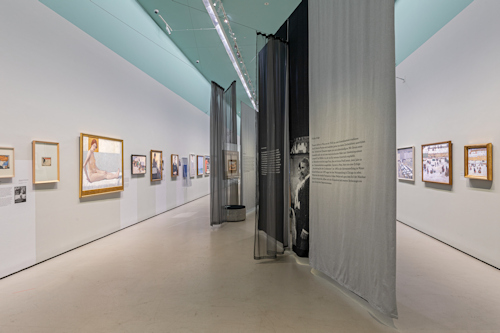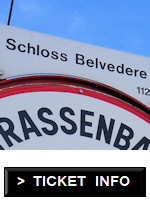Broncia Koller-Pinell can claim the rare achievement of being an accomplished and influential artist but also a sponsor and supporter of the arts. An exhibition at Lower Belvedere does justice to both roles.
- Features works from across her career
- …also alongside related art by contemporaries
- e.g. Egon Schiele & Koloman Moser
- Runs Mar 15 – Sept 8, 2024
- Book Lower Belvedere tickets* online
- See also
An artist and her network

(Broncia Koller-Pinell, self-portrait from around 1905; press photo © Landessammlungen NÖ)
Turn of the century Vienna might be held up as an era of creativity and intellectual progress, but women had yet to gain full voting rights. Nor could they even pursue academic art studies at the time.
Now add in the kind of anti-semitism that would later explode into tyranny, and you can imagine the chances for a Jewish woman to become an artist of some repute were, well, low to say the least.
All of which makes the achievements of Broncia Koller-Pinell (1863-1934) even more impressive: an accomplished, recognised and influential painter, but also a lynchpin of the artist community and supporter of new talent.
The political era that accompanied and followed Koller-Pinell’s final years meant those achievements were often neglected. An exhibition at Belvedere helps restore her to a position that more accurately reflects her ability and status.
Born in Sanok, Galicia (now modern-day Poland, but then part of Austria-Hungary), Koller-Pinell moved to Vienna as a young child where she spent much of the rest of her life.

(View of the exhibition; press photo © Johannes Stoll / Belvedere, Wien)
Although already exhibiting works in her late twenties, Koller-Pinell’s artistic star reached its zenith with her involvement in the Wiener Moderne. She participated, for example, in the legendary Kunstschau exhibition of 1908, where her art shared a venue with a certain golden painting we know as The Kiss.
(We see, for example, Koller-Pinell’s 1905 Girl with Red Hair woodcut from that same show.)
This association with pioneering art movements came about both through Koller-Pinell’s own artistic contributions, but also socially. Together with husband Hugo Koller, she served as enabler and catalyst for others, sitting at the centre of a network of talented individuals.
Koller-Pinell moved in a circle that featured such personalities as Gustav Klimt, Koloman Moser, Egon Schiele and Josef Hoffmann, thereby nurturing mutual influence and exchange.
The couple’s residence(s), for example, became a regular meeting place for artists and other creatives, including Gustav and Alma Mahler (whose daughter, Silvia, was briefly married to Koller-Pinell’s son).

(Might be just me, but is there a hint of Klimt in this landscape? Broncia Koller-Pinell, Orange grove on the French Riviera, 1903; press photo © Belvedere, Wien)
The connections and closeness of those relationships comes through in the art displayed in the exhibition.
We see, for example, a portrait of Hugo Koller by Schiele. A drawing of Schiele’s wife by Silvia Koller, who became an accomplished artist in her own right. One of Silvia Koller herself by Koloman Moser.
The respect at that time for Koller-Pinell’s art shines through in portraits of her by contemporaries, who position her as an artist of repute, rather than a wealthy socialite.
This regard also appears in paintings clearly influenced by Koller-Pinell, such as Heinrich Schröder’s post-1906 The Roof of the Theater an der Wien, which owes much of its composition to Koller-Pinell’s earlier c.1903 The Large Roof.
The highlights from the artist’s own oeuvre illustrate her skill and follow her stylistic evolution from the very first oil painting (a medium where she was self-taught!) and the Munich School through Impressionism and beyond into New Objectivity.
Dates, tickets & tips
Enjoy exploring Koller-Pinell’s work and influence from March 15th to September 8th, 2024. A ticket for or from Lower Belvedere includes access to the special exhibitions within.
(Booking service provided by Tiqets.com*, who I am an affiliate of)
For a bonus Broncia or two, so to speak, visit:
- The Who Cares? exhibition in the Jewish Museum, which has her unfinished work Mother with Child from c. 1900 on display
- The permanent Vienna 1900 exhibition at the Leopold Museum, which has at least one Koller-Pinell if I recall right and is a top address for the wider Wiener Moderne anyway
Needless to say, dipping deeper into the artistic side of that particular era is relatively easy in Vienna.
Upper Belvedere has the Vienna 1900 section of its permanent art exhibition, for example, with its world-leading Klimt collection. As mentioned, the Leopold Museum has a focus on that time period, as does the MAK museum.
Schiele’s presence in Vienna’s art museums seems to grow each year. The Leopold Museum is your top alternative, but last time I visited the Albertina permanent exhibition, Egon had a whole room to himself (and a special exhibition expected in late 2024).
For more tips, check the overview articles on Schiele, Klimt and the Wiener Moderne.
How to get there
Just follow the travel advice at the end of the Belvedere directions page.
Address: Rennweg 6, 1030 Vienna
